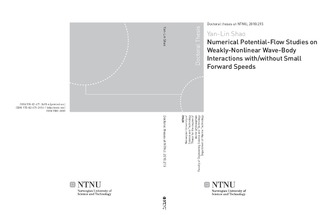| dc.contributor.author | Shao, Yan-Lin | nb_NO |
| dc.date.accessioned | 2014-12-19T12:05:42Z | |
| dc.date.available | 2014-12-19T12:05:42Z | |
| dc.date.created | 2010-11-30 | nb_NO |
| dc.date.issued | 2010 | nb_NO |
| dc.identifier | 373408 | nb_NO |
| dc.identifier.isbn | 978-82-471-2415-4 (printed version) | nb_NO |
| dc.identifier.isbn | 978-82-471-2416-1 (electronic version) | nb_NO |
| dc.identifier.uri | http://hdl.handle.net/11250/237758 | |
| dc.description.abstract | A two-dimensional Quadratic Boundary Element Method (QBEM) and a three-dimensional cubic Higher-order Boundary Element Method (HOBEM) are developed to study respectively the twodimensional and three-dimensional weakly-nonlinear wave-body interactions with/without forward speed within potential flow theory of an incompressible liquid.
A direct method based on a triangular polar-coordinate system transformation for the evaluation of the Cauchy Principle Value (CPV) integrals for the diagonal terms of the influence matrix in the 3D HOBEM is presented.
A numerical module based on the Fast Multipole Method (FMM) is developed, which can be used as an option to speed up the present 3D HOBEM solver. Both the operation count and the required memory of a FMM accelerated BEM is asymptotically O(N), where N is the total number of the unknowns. Suggestion on the selection of a proper matrix solver for a specific problem is given.
A new approach based on domain decomposition using body-fixed coordinate system in the inner domain and the inertial reference frame in the outer domain is proposed for the weakly-nonlinear wave-body analysis. Consistent theoretical description of the new method based on second-order theory is presented. The new method does not require any derivatives on the right-hand sides of the body boundary conditions and thus avoid the mj -like terms and their derivatives. Furthermore, because the body boundary condition is formulated on the instantaneous position of the body, the resulting integral equations are valid for both smooth bodies and bodies with sharp corners. In order to improve the convergence of the second-order forces/moments on a body with sharp corners in the near-field approach, a re-formulation of the quadratic force is suggested. This re-formulation transfers the integrals on the body into the sum of two groups of integrals. The first group contains integrals on body surface with integrands whose singularities are weaker than that of the velocity square. The second group consists of regular integrals on the inner free surface and the control surface in the inner domain.
A two-dimensional third-order numerical wave tank (NWT) is developed. The effect of the Stokes drift in the second-order solution is discussed. A two-time scale approach is proposed as a secularity (solvability) condition in order to avoid unphysical third-order results. The numerical results for the second-order diffraction/radiation of a horizontal semi-submerged circular cylinder are verified by some other analytical and numerical results. Comparisons with the experimental results are also made.
The second-order wave-body interaction with/without the presence of a small forward speed for a three-dimensional floating body is studied by both the traditional method (if applicable) with a formulation in the inertial coordinate system and the new method with a formulation in the body-fixed coordinate system near the body. Both bodies without sharp corners and a truncated vertical circular cylinder with sharp corners are studied. Comparisons between the present numerical results with some other analytical and numerical results (if any) show good agreement. The influences of a small forward speed on the second-order wave loads on floating bodies are investigated.
The complete third-order wave diffraction of a stationary three-dimensional body is studied by the time-domain HOBEM, which means that the solution contains not only the triple-harmonic effect but also the third-order contribution with fundamental frequencies of the incident waves. Careful convergence studies and alternative way of calculating the force have been made with very satisfactory results. | nb_NO |
| dc.language | eng | nb_NO |
| dc.publisher | NTNU | nb_NO |
| dc.relation.ispartofseries | Doctoral Theses at NTNU, 1503-8181; 2010:215 | nb_NO |
| dc.title | Numerical Potential-Flow Studies on Weakly-Nonlinear Wave-Body Interactions with/without Small Forward Speeds | nb_NO |
| dc.type | Doctoral thesis | nb_NO |
| dc.source.pagenumber | 220 | nb_NO |
| dc.contributor.department | Norges teknisk-naturvitenskapelige universitet, Fakultet for ingeniørvitenskap og teknologi, Institutt for marin teknikk | nb_NO |
| dc.description.degree | PhD i marin teknikk | nb_NO |
| dc.description.degree | PhD in Marine Technology | en_GB |

